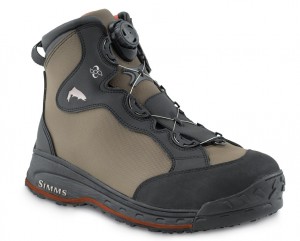Epic Blog
Simms RiverTek BOA Wading Boot
11.07.11
I tried the Simms RiverTek BOA wading boot during the 2011 guiding season at our Alaska Wilderness SAFARI camp.
Note that I normally wear the Simms Rivershed boot in Alaska (which I like very much), but due to inventory issues (my fault for placing a late order), I ended up with the RiverTek BOA boot instead.
Also note that as of 2014, Simms has updated their design to the RiverTek 2 BOA.
THE GOOD
- The BOA lace system does clearly solve one constant issue with wading boots: The laces DO NOT come untied, nor does the boot loosen up throughout the day. This is a real improvement to wading boots.
- The boot comes off lightning fast (as long as the relase knob isn’t sticking, see #1 drawback below).
- The boots feel “light in the hand.”
- The StreamTread sole works well, as already established over several seasons fishing in Alaska.
THE DRAWBACKS
- The BOA mechanism itself was occasionally hard to release (it felt “sticky”), and it was difficult to release with very cold fingers. I did eventually figure out that pulling on the release knob and pushing down on the tongue with the other hand at the same time offered some help in both situations.
- Due to our coastal (salt and sandy) environment, I do not have great confidence in the ruggedness and/or longevity of the BOA mechanism itself. I had no mechanism failure this summer (nor I have I heard of any), so this comment is purely perception. FYI, there appears to be an internal ratchet mechanism that tightens the laces… I believe it is bound to have problems down the road unless you rinse out the salt and sand daily.
- Putting the boot on and achieving a good snug fit takes more time than expected. You basically have to wiggle your foot back-n-forth while tightening the lace system. This helps move the wire through the plastic guides more efficiently.
- Upon a BOA lace system failure, improvising or repairing the laces appears challenging. A standard boot lace is easily replaced on the stream (or at a remote Alaska fishing camp) with spare laces or a length of p-cord.
- Overall, the boot takes more of your time than a regular laced boot.
CONCLUSION
Although I did thoroughly appreciate my laces staying put all season, my next pair of wading boots will have a standard lace system for one simple reason: because I can repair it easily in the field.
These boots will likely work perfectly (and save a lot of traditional lace frustration) for an average angler, but the grass is not necessarily greener for me… I don’t completely trust the BOA system in a remote guiding situation.
Full disclosure about Product Reviews.


